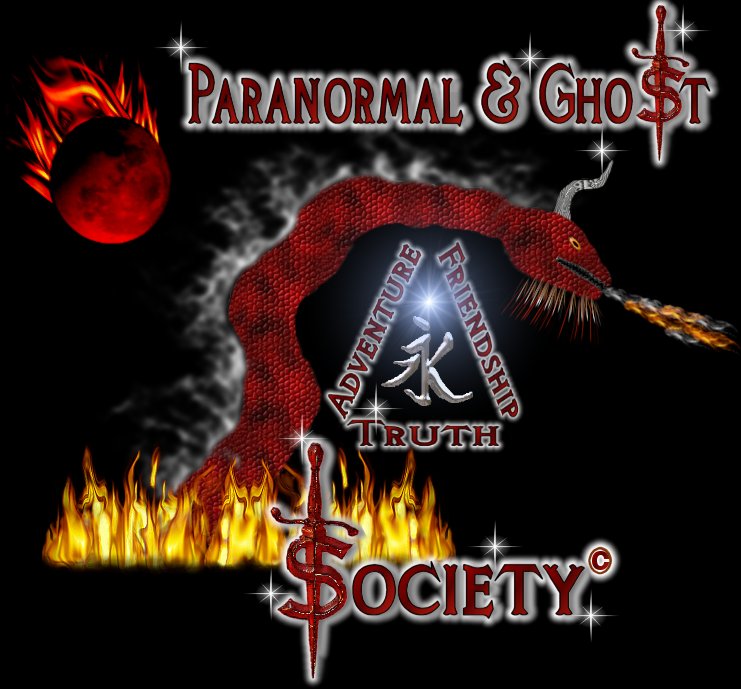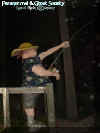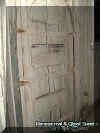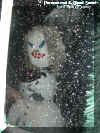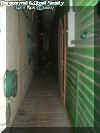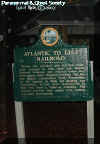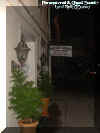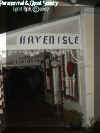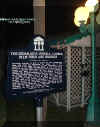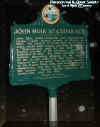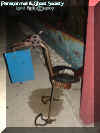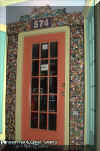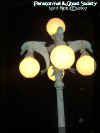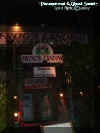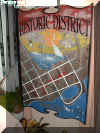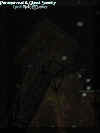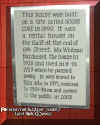|
|
|||
|
When some people hear about Cedar Key they think to themselves paradise....a fishing village...a romantic getaway...then some of us who are history buffs and paranormal investigators think to ourselves a deeper darker history which often the islanders forget about. The old saying to the island is time stands still and life slows down in Cedar Key. Not only is the island very old so is the bay surrounding it. Often known as Waccasassa Bay it dates back from the Pre-Columbian Period to early pioneers to the Civil War to a Timber Harvesting area. Those people around the bay built homesteads then hunted deer, turkey and bear. They would cut down timber...hunt cows...and face the harsh conditions that this island was battered with by storms. The hammock trees were used in providing development of Cedar Key which would provide cedar for the pencil factories...and palms for the fiber factory. Today one that would hike along the bay could still find the boilers once used in the production of brushes and brooms made from sable palm fibers on the preserve outside of Cedar Key. Cedar Key really is not one set island but rather a series of little ones...for example one called Salt Island which is named for the salt Kettles found here which were used to extract the salt from salt water during the Civil War. Many Indian artifacts and pioneer sites can be found on the preserve south of Cedar Key. Now that is just the preserve surrounding the island so lets get into the more deeper island history. Cedar Key was settled in the early 1840s by an Augustus Steel and by 1861 it was technically the largest city in Florida. It was bustling because of the Cross Railroad which ran from the port to the east coast in Fernandina. That railroad could carry turpentine, cotton, seafood, lumber and passengers from the Gulf Coast To the Atlantic Coast. If you remember David Yulee's Sugar Mill we investigated he also was the railroad owner. A very wealthy tycoon and sugar mill owner. Salt was a key commodity in the 1800s and this area. The salt would be collected during the Civil War for the Confederacy from the sea water in kettles and boilers surrounding Cedar Key. In 1862 however a Federal force had attacked the salt operations by sea and captured Cedar Key. The Kettles and Boilers were demolished to deprive the Confederates of needed supplies. I was told during its demolishing the city was burned down I am guessing people died. South of Cedar Key is a town called Yankee Town perhaps this was called this due to the Union Forces in the area. When the war had ended Cedar Key actually grew in sized and became one of the largest ports in all of Florida as it became a center for ship building, fishing, and timber. In 1896 a terrible hurricane struck the island destroying most of the town only leave a small fraction behind and that fraction is what we investigated mainly. They say Cedar Key is a lot like Keywest 50 years ago today being a small resort and fishing town. It is one of the oldest ports in the state and the site of one of the first railroads in FL. Today times have changed its a fairly quiet place full of sea captains and fishermen who live off the sea. Many artist and writers come to find this place inspirational for their work. The town is full of historic streets with galleries, shops, exotic sea food restaurants and some barrier islands that I heard you can walk to when the tide is low. Downtown right on the lawn of residents Midden Mounds can be found. I did not see this during my walk in downtown Cedar Key then again I did not want to disturb the locals by traversing on their front lawn. One of the mounds in 1883 was discovered by an S.T. Walker who was an archaeologist from Clearwater. He dug about 12 feet out of it and found pottery. Based on the different levels were various pottery. Like the bottom few feet had thick very course and thick pottery. That was tempered with gravel and sand. The next four feet had thin pottery with rims turned outward. Then higher for about three feet up was some check-stamped pottery found here. Finally the next two feet after that had little pottery and the top three feet of the mound had pottery with handles and ears. It was decorated with zigzag lines, dots and curves and some were painted. Walker assessed that the pottery was from four different cultural periods from about 299 B.C. Until 1200 A.D. The sand dune beneath that mound was a million years old. Somehow I missed it or passed these mounds but then again I probably looked at it just did not think nothing of it cause basically what it looks like today is just a small hill with a house on it lol. There is a few areas where there are shell mounds another one is near the Cedar Key Lions Club so we know the Native American people were the first on the island. But see today the island is not known for its history its also known for its amazing bird watching. They have sanctuaries for birds here throughout the barrier islands. Birds like the white pelicans, herons, white ibis, cormorants, anhingas, egrets,roseate spoonbill, and even the bald eagle. The nature around the island varies just as the habitats do from salt marshes to Indian shell mounds. If you want to get technical there is 12 barrier islands surrounding Cedar Key. For example Sea Horse Key the outermost island was used as a military hospital and served as a detention camp that captured native Americans during the second Seminole war in 1835. A lighthouse sits on that island and was built in 1851 then abandoned in 1952. Now the lighthouse serves as a center for marine research and environmental education. The island is what it is a giant sand dune that is 52 feet in height perhaps even the highest point on the states west coastline. Then we have another island that is up to 20 feet above sea level covered in live oaks, laurel oaks, cabbage palms and red baby. There is also verdant under story, saw palmettos which I hate lol, cherry laurels, yaupons, wild olive, red cedar, Spanish Bayonets, and prickly pears. Some of that island has salt marshes and mangrove swamps. Since part of that island gets flooded in the lower areas. A few other islands are Snake, Bird, North and Seashore islands all designated as wilderness areas. Of course people from Cedar Key get on their boats and chill on these islands. If I had a boat I would to or if the tide was down I would not mind swimming out to a few. They are really not that far away from Cedar Key. Hoover the president of 1929 made this place a refuge which would protect the Snake and Bird also known as Deadman's Island and the north keys. That is actually what Cedar Key is called is the keys of the north since they branch out into the Gulf in North Western Florida. People camp on some of the islands while some only appear during high tide or low depends really on the island from what I read. Anyways I got most of the boring stuff out of the way now lets get to the meat of things and discuss Cedar Key itself. Cedar Key was originally called Depot Key or anotherwards "Atsena-Otie" which is a Creek Indian word meaning Cedar Island. Judge Steele in 1843 was the first settler to build a house on the island. During the second Seminole War before this the Army used the island as a supply depot and hospital. But from what I hear they did not use Cedar Key but the island off of it. Still they would probably launch there boats from Cedar Key since it was the closest to the coastline. In 1843 Judge Steel did purchase the military buildings for his own use on the island(s). The Second Seminole War went from 1835 to 1842. US Army quartermaster and early settler Mr. Parsons had the first prefabricated building in Florida when he cut and assembled the timbers to his home on Way Key another island nearby. Of course the Floridians should thank him because nowadays they are called Mobile homes which lots of lives are lost in them due to Florida's hurricanes and storms. But at least NOW you know where they came from. Anyhow he moved his prefabricated home to Atsena-Otie and reassembled it. In 1854 a major hurricane struck the island Atsena-Otie/Cedar Key and apparently alot of people died. I am not sure in this history part of it because the way I read it sounds like the hurricane washed up bodies ant the bodies were reburied on Way Key. But what I think they meant to say is that when Cedar Key was at its peak the hurricane hit people died and instead of burying them on the island they actually buried them on Way Key which is another island Near Cedar Key. After that alot of the population from Cedar Key actually shifted there lives to Way Key for reconstruction since Cedar Key had been badly damaged from 1865 to 1876. Anyways Judge Steel wanted Cedar Key to be a resort colony for local wealthy plantation owners. He served as the towns first postmaster and established the post office here in 1845. A town is not a town till you have two things a post office and a railroad. Of course the post office was moved in 1852 to Way Key even before the hurricane however lets get into the railroad history here. The first train arrived on the island in 1860 the railroad was chosen to go here because it had a deeper harbor and was closer to New Orleans. It was Yulees dream to connect Cedar Key and many other major cities together using the railroad. The train did not last very long because in 1862 the station was destroyed by troops on both sides during the civil war. Plus the Florida Railroad Company became the Atlantic Gulf and West Indian Transit Company in 1872. It did not put an end to the railroad but it hurt the island for many years. In the 1880s a new depot was built called the F.T&P. Railroad Company. It was not a very large operation the train tracks ran north to the mainland and south to the Wharf. The wharf I believe no longer exist its just a bunch of wood pylons out in the water. Eventually new tycoons building railroads would come into play one of those named Henry Plant completed his rail line linking Tampa Bay to the east coast. The line that linked Fernandina to Cedar Key was used less as the town declined and Plants line called the Seaboard Air Line Ratline would emerge and prosper. Railroad activity in Cedar Key ended in 1931 and by 1932 all the tracks were removed including the old trestle which a part of it can be seen sitting on someone's property lol. Now aside from the railroad other things were happening around the island to. Like in 1849 the Island Hotel was built. It then became the Parson and Hale general store when the railroad reached here. The hotel and store was also used as a customs house and post office. After the Civil War the rooms upstairs were rented by guest and the second floor verandas were added. It did not stay open to long due to the decline in the cedar industry and Frank Hale's death in 1910 operations had cease. Despite the tragedy that occurred in Cedar or should I said fires and storms this hotel has survived more perhaps then any structure. In 1915 the store was renovated called the Bay Hotel and by 1919 a whiskey still was discovered in the attic and was reported to his manager by Feinburg which was against the law. Well the manager agreed to remove it but also had Feinberg stay for lunch. Feinberg did and immediately after eating fell into a deep sleep to never awake. I think he was murdered or poisoned its quite obvious when you look at all the facts. Anyhow it was purchased by the Territe family for awhile and by 1925 it was acquired by a Mr. Fowler who called it Fowlerwood. During the great depression the Cedar Key Savings Bank foreclosed on the property and during the late 1940s it was purchased by L.C. and Bessie Gibbs who renovated it. The hotel has a Jamaican style to it with a Masonry Vernacular style, with a flat roof, parapet walls, and a sheet metal roof which blew away during a very terrible hurricane in 1950. The foundation and its walls are made from oyster shells, shell lime, sand and water poured into thick wood frames. The original wood doors...French doors..and mural walls all have been preserved since the 1800s. One of the hotel rooms here was named The Richard Boone Room for a frequent visitor who starred in Televisions show called "Have Gun Will Travel" Today the hotel is rumored to be very haunted. I have posted a piece on the hotels history in depth below along with many ghost stories only because this is one of the most famous sites on the island. I did visit the outside of the hotel but did not really take photos because of the guest did not want to be rude. Another story on the island is about a Faber Pencil Company called Cedar Mill ran by Henry Winter who employed about 100 workers on the northwest shore of the island. was the plant manager. Dbherhard Faber had purchased alot of the land in Cedar Key for the soul purpose of exporting cedar logs to Germany and NJ. Graphite was imported from Siberia and put into pencils at this factory here built in 1865. In 1879 Faber Sr. died and the mill was just about out of Cedar wood. Those mills were damaged by a storm surge during a hurricane in 1896 which caused the closing of the mill in 1899. When I say storm surge I mean basically the mills were under water since they were built right near the shore. As I also said Figer Plants were a part of the history as well. In the 1860s the Fenimore Steam Saw and Planing Mills were in operation. Later it was the site of an oyster canning plant. Dr. Dan Andrews and his three brothers brought the plant in 1906 and converted it into a broom factory with cabbage palms used for bristles. It produced a line of Donax brushes. In 1910 the Standard Manufacturing Company was founded and had 75 workers on the island. The brooms were displayed in 1933 at the Chicago Worlds Fair Century Of Progress event. In 1952 that plant closed down as a result of hurricane Damage and drop of labor force during WWII. Nearby was the Cedar Key Light and Power Company in 1920. You can clearly see that each business had a downfall on the island or rather a pattern here. Then there is another old site which existed in the 1860s and 70s called the Suwannee hotel which had 200 rooms. It was the main social center for Cedar Key. R.H. Mcllvane operated it during the 1880s. That no longer exist either. Much like the Gulf House that was located nearby in the 1880s who A.B. Wheellock was its proprietor. But before it was a hotel it was known more as a gambling, saloon and old west type of establishment. Some of Cedar Keys first sidewalks were constructed of wood near the Gulf House and Suwannee Hotel. The most famous place in my opinion of Cedar Key is the City Docks. Imagine wharfs...old wood hotels...piers...and just dozens of docks with sea boats. I am sure you can envision this. The businesses in Cedar Key were built on these docks which included the law office of E. J. Lutterloh in the 1880s. The train track and buildings where the marina stands today was a bunch of piers and structures. Prior to this in the 1880s Cedar Key was the busiest port town in Florida. The population was 5000 people as opposed to today its around 700 people. The cedar trees could be used to make pencils then they were shipped out at the docks. The hurricane that struck the island in 1896 almost destroyed the entire town. As I discussed earlier above how the surge ruined the pencil mills it also flooded the entire town which a 10 foot surge. Not only that but right after the hurricane a second fire would hit the town in addition to the Union Attack of 1862 that fire destroyed the Bettelini House Hotel which was built in 1878. Now if I jump back in time about the city docks area...It was this site that also faced the most damage in the civil war and the end of the line for the Florida Railroad. The Union came here in 1862 with a blockade ship called the U.S.S. Hatteras which had marines and sailors on board. They destroyed freight cars, cotton stores, warehouses and turpentine mills as the town was abandoned burning it all down. In addition to it it was at these docks 8 ships were burned down in the harbor. I just wanted to elaborate more on this since above I did not get to deep on how the railroad was destroyed or how the town caught on fire. Perhaps one of the most famed sites is the Clair Whitman House which was moved to the Museum on the island. But before it was moved it sat near Goose Cove in front of an Indian burial mound . Eventually wings would be added to this house and he always had an interest in artifacts and shells. His collection when to the museum on the island. If you were to visit the island today and you seen the Whitman Point Townhouses that is where their house at one time stood. We did visit this house which sits near the museum and they even have a nature trail behind the home you can walk through its pretty historical and picturesque. Clair Whitman was the operator of the islands first museum so of course the collections and home all have become part of the museum state park on the island. The museum was named after a man who invented many tools and machines which were used by the Standard Manufacturing Company in their production of Brooms. Whitman died in 1959 and the museum had been opened in 1962. The land in 1960 was donated by the Cedar Key Stores Inc. for the state park and museum. Not to far away from the museum is the George Lewis Airstrip. Its 2,500 feet long and 100 feet wide. We actually drove right along the landing strip and I took a photo of an airplane. There is a sign warning cars of low planes its pretty cool really. The last interesting site which we did visit is the Cedar Key City Park. It was built after the hurricane in 1950. The park is also the site of the old depot and near the city docks. The original city dock and fishing pier were rebuilt with the WPA funds in 1935 but were destroyed by hurricane Easy in 1950. A new dock was made out of cement in 1968 not to far away from the City Park. It was dedicated in memory of Peter Baylor a Levy County Commissioner who was also responsible for getting the country to donate the land and funding for such projects. Today alot of the piers and city docks are nothing but wood pylons. One of our assistants told me she use to fish all the time on the pier and that was gone. In its place it appeared that all the heavy machinery...cranes etc were about to rebuild or build a new type of pier perhaps a more sturdy one considering this island has been plagued by storms, water surges, fires and disaster. At some point in time Cedar Key was a ghost town its growth has been stunted by disaster and with that disaster comes a series of many ghost stories told by the locals of sea captains...native Americans...and historical figures prominent to the growth of this island. Its a place where time slows down well not according to the couple having sex in the city park we ran into out in the open lol. But it is a place on the sea its not very modern alot of old structures on the island. Many of the houses and structures are built on stilts and concrete slabs. I seen a condo over 30 feet high sitting on concrete blocks amazing huh? But that is how life is on the island. Just as the local cemetery has clam shells spread atop each grave to keep the sand in tact in case of a surge so the bodies do not wash up. Lastly there is an old famous legend passed down over the years on the island. Its called the Legend Of Mermaids Landing which takes place right near where you enter onto the island near some cottages today. The local legend has it that while walking on the railway bridge which once crossed the shallow bay...a naturalist from the 1800s named John Muir caught site of a mermaids tail. Some say he had malaria and was delirious. But anyways when he recovered from this he started tearing up his notes and books he wrote of his journeys. A friend had seen the passage where Muir described a glistening green tale full of scales and a flash of golden hair while he was relaxing on the old metal railroad bridge. His friend obviously stopped him from tearing up this page about how his Fevered Eyes Beheld such a beautiful site so that it could be shared and passed around amongst the islanders. So not only does the island have local ghost stories it also has a Mermaids tale. Each year their is a paranormal conference on the island sorry for those reading I did not get to attend. But I can say I was lucky enough to visit this island before my transition out to CA and walk around a place full of history, tragedy, death, war, beautify and mystery! © By Lord Rick Bad Santa Pays A Visit To The Good Little Boys and Girls Of Cedar Key Lord Rick Founder At Dennys After The Investigation Almost All That Is Left Of The Old Cedar Key Offshore Many Cats Plague The Island I have Photos Of 6 Can You Find Them All Hint One Is Further Above The Island Hotel & Its Ghost
The Island Hotel is one of Florida's most famous "bed and breakfasts" and is listed on the National Register of Historic Places. The building was constructed in 1859 and is built from seashell tabby with oak supports. The walls are almost 12 inches thick and have withstood countless storms and hurricanes. The hotel has "settled" and its sloping floors have survived the passage of time, many guests, and several feet of water every time a storm blew the roof away. The building was originally built as a general store and post office. Very little has changed it over the years. A small bar was added on the ground floor and was painted with murals of Cedar Key in 1945. A large picture of King Neptune and his court is prominently displayed over the bar, hence the name "King Neptune Lounge". Major
Parsons built the structure and named it "Parson and Hale's General
Store". At the same time, Cedar Key began to expand. During the Civil
War, Union soldiers burned down almost every building in Cedar Key except
the general store. They used the hotel as officer quarters and as a
warehouse. Just before the end of the Civil War, the Confederacy
"retook" the town and officers of the Southern Army were
billeted in the Hotel. In 1896 a major hurricane severely damaged the town and the store. Soon after, Francis Hale, one of the original owners, died. In 1914 Langdon Parsons, a relative of John Adams, sold the building to Simon Feinberg, who turned the building into the "Bay Hotel". As part of the renovations, a second-floor balcony was added to the southern and western sides of the hotel. The Bay Hotel was managed by a man named Markham. It's said that Fineberg found out about an illegal liquor still Markham had built in the attic, which was against Feinberg's religious upbringing. Feinberg told Markham that he wanted to meet to "talk about some problems". Markham arranged a dinner meeting with Feinberg during which the liquor still problem was discussed. Markham professed his innocence. Feinberg retired for the night but never awoke. He died of food poisoning. In 1999, while remodeling the hotel annex, previous owners found the remains of circular copper piping commonly used to condense liquor in stills. There have been many owners over the years. It had been named the "Cedar Key Hotel" in the 1920's and "Fowlers Wood" in the 1930's. The hotel nearly burned to the ground during the depression, when it operated as a speak-easy and brothel. Each fire was quickly extinguished by the local fire department who, it is said, spent most of their spare time at the hotel as customers During World War II the hotel became run-down and unlivable. In 1946 Bessie and Loyal Gibbs bought the building and set out to revitalize it. They restored the place and renamed it the "Island Hotel". During their ownership, the hotel and bar became a notable hangout for local characters and celebrities alike. These included Pearl Buck, Vaughan Monroe, Tennessee Erie Ford, Francis Langford, Myrna Loy, Richard Boone and John MacDonald. Hurricane
Easy lambasted Cedar Key in 1950, blowing the roof off the hotel. Major
remodeling was required to make the building usable again. Loyal Gibbs
died in 1962. Bessie continued to operate it until she retired due to
health reasons in 1973. Bessie died two years later in a house fire at her
small cottage home in Cedar Key. In
the late 1980's, one owner, Marcia Rogers, converted the King Neptune
Lounge into a juice bar. Her actions so infuriated the local patrons of
the King Neptune Lounge, that they buried her in effigy outside the town
hall. There
is the story of the small black boy, about nine years old who died before
the end of the Civil War. There is the story of the Southern Army private soldier who stands guard on the second floor. No one seems to know the reason or the whole story, but sightings of this apparition out-number all of the others. It seems that every morning just as the sun begins to rise guests can see what appears to be a soldier in a Southern Army uniform standing guard at attention just inside the doors leading to the balcony. The vision lasts just a few seconds but has been seen by dozens of guests over the years. Then there is the story of Simon Feinberg, who according to folklore was poisoned by the hotel manager, Feinberg is said to be a "wandering ghost" who walks around the hotel, especially at night, appearing briefly to startled guests and staff. He too seems to be harmless at least if your name isn't Markham! There's another story of the ghost who visits guests staying in rooms 27 and 28. This spirit is said to be that of a murdered prostitute. . . an undocumented event that occurred during prohibition times when the hotel was a speak-easy and brothel. This shy ghost is quite friendly. She simply sits on the bed in the middle of the night and kisses guests on the cheek, then disappears in a smoky haze. There
are sightings of more recently departed people. Bessie Gibbs, who lived
here for over 26 years, is said to move around the hotel rearranging
furniture, pictures and closing doors. It seems her favorite trick is to
lock a guest out of his room as he steps out for a moment. Guests have
also seen a ghostly apparition walk through their room and through the
walls in the middle of the night. They always describe a spirit resembling
Bessie Gibbs. Bessie was a character in life, ever full of stories, jokes
and playfulness. Her ghostly apparition continues just the way she was. There is evidence that, in addition to those ghosts listed above, two Native American Indians, a fisherman and an unidentified tall, thin man are also making the hotel their post-earthly form home. One investigator claims that Bessie's room is probably a portal to another dimension. He also believes that the front of the hotel is another location with strong paranormal activity. Lights will flicker, doors open and close without a known cause. There are always cold spots, breezes and drafts without reason; and some report the pervasive feeling of being watched or followed. The
Fox Network television series Haunted Inns & Mansions filmed a segment
at the hotel in 1999. Whenever a local Fox affiliate anywhere in the
United States replays this episode, reservations spike as people search
for "proof" that ghosts actually do exist.
|
|||
|
|
|
